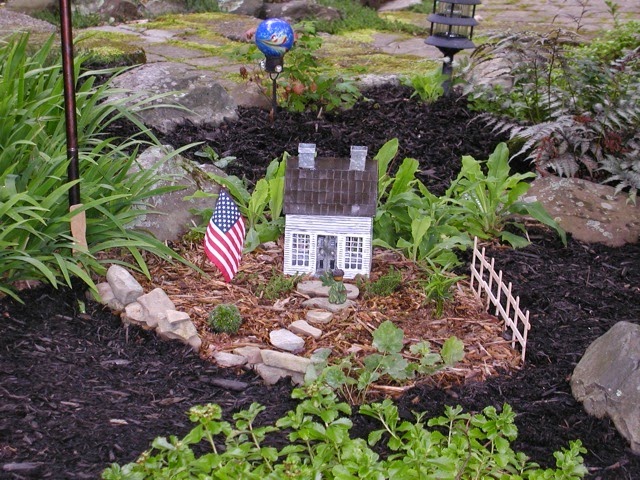With the temperature ten degrees below normal, it feels like fall this August Bloom Day. I love the cool air and clear, blue sky following a day of soaking rain. My plants love this weather, too, and the garden is more beautiful than usual for the time of year. Usually, ever flower is struggling in extreme heat and humidity. What a different and strange year it's been so far.
On my morning walk I tried to photograph what is new, but couldn't resist adding a couple of old friends to the pictorial mix. Let's start with the pond garden, or as my grandson (a Beatles fan) calls it, "Octopus's Garden."
 |
| Angel Falls |
 |
| The water lily is just opening its petals to the morning sun. Can you see Mr. Bullfrog? |
Octopus's Garden, surrounding the pond, is full of color with cleome, butterfly bush, Russian sage, perennial geranium, and the deep red leaves of the Japanese maple...
Rozanne is a hardy geranium. This is the true geranium, not to be confused with the annual pelargonium. It grows, reliably, in several parts of my garden. Here it is in the rose garden.
 |
| Old friend, perennial geranium, Rozanne |
My roses suffered horribly this past winter. I lost some and had to cut back others so severely they failed to produce flowers this year. One rose, my yellow Knockout, is attempting to bloom, but as the buds appear they are greedily devoured by Japanese beetles.
 |
| Knockout rose bravely bearing buds. |
A plant bearing yellow flowers with much more 'blooming' success is the threadleaf coreopsis.
 |
| Threadleaf coreopsis |
Not many butterflies are visiting my garden this year. I am so sad! Every day I examine the milk weed for eggs or caterpillars, but I am not finding them. I have spotted only a couple of monarchs passing through. The blooms of the butterfly bushes entice them to stay. Please stay ...
 |
| Phlox, shasta daisies, and pink butterfly bush. |
 |
| Purple butterfly bush, daylily 'Chicago Apache,' and cleome. |
Behind the shasta daisies I see blue mist shrub has started to bloom.
 |
| Shasta daisies and blue mist shrub |
I planted containers with zinnias and placed them at the end of the path to provide a 'destination.'
 |
| Path through octopus's garden. |
Entering the kitchen garden I am delighted to see a clematis is still blooming on the arbor.
New this year, I planted borage among the vegetables to attract pollinators. It's striking blue flowers are real bee magnets. I just wish the bees would stay on each bloom long enough for me to take pictures. Please stay ...
 |
| Borage (herb) |
As always, I planted annual flowers in the kitchen garden.
 |
| Zinnias, delphiniums, and marigolds. |
Obedience is full of bees...
 |
| Obedience plant. |
 |
Finally, at the edge of the top field I found an 'escaped' Turk's cap lily with wild, puple phlox behind it...
 |
| White phlox in the butterfly garden. |
A perfect summer day is when the sun is shining, the breeze is blowing the birds are singing, and the lawn mower is broke. --James Dent
Thank you, Carol, for graciously hosting Garden Blogger's Bloom Day each month. What a joy to see all that's blooming around the world.
Happy GBBD,
Pamela x
~~ I love reading your comments. I hope you leave one so I’ll know you visited!
I look forward to visiting your blog in return.






















